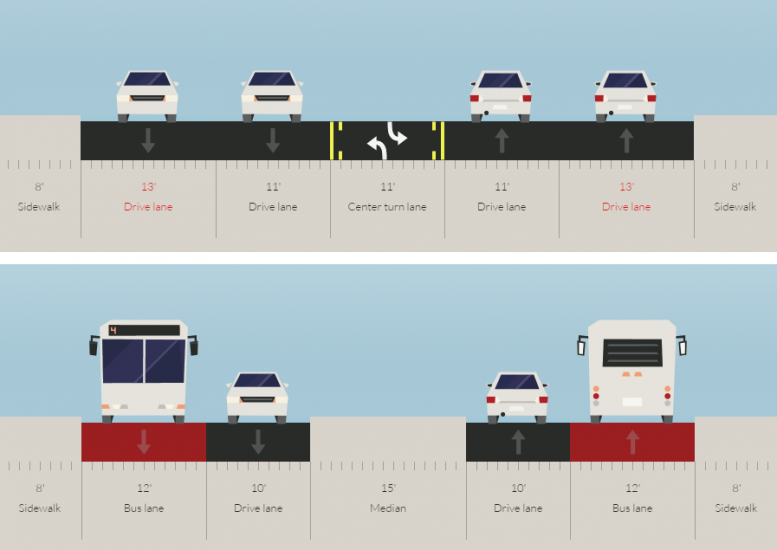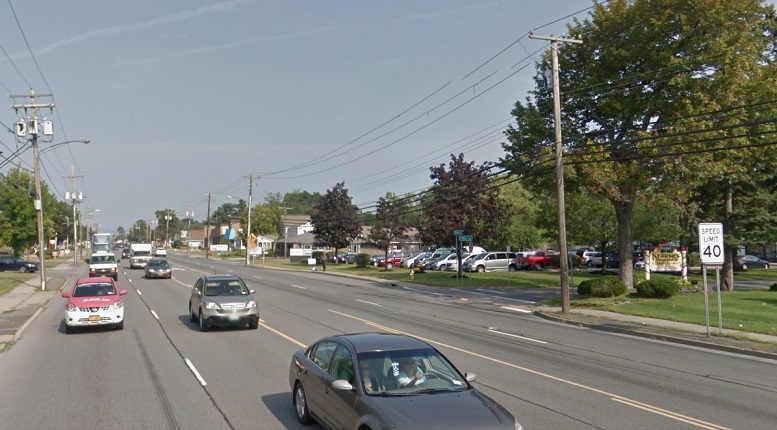Another pedestrian has been killed trying to cross Central Avenue in the Capital District:
COLONIE – A 62-year-old woman was hit and killed while she was trying to cross Central Avenue in Colonie Tuesday morning.
Borziloke Zakolli of Colonie had made it halfway across when she was hit by two different cars and killed at the scene.
A key fact that none of the reports mentioned is that the signalized pedestrian crossings on this stretch of Central Avenue, also known as Route 5, are spaced almost a half-mile apart. Zakolli was attempting to cross between Tull Drive and Breeman Street. In order to get to a signalized crosswalk, she would have had to walk almost a quarter-mile to an intersection, and then double back another quarter-mile, which would have added at least eight minutes to her journey (plus time to wait for a WALK signal and cross).
In 2014, NYSDOT completed a “very aggressive” 18-month study of the corridor which found that 75 percent of people crossed outside of crosswalks or against crossing signals, something a NYSDOT spokesperson called “pathetic.” But what’s even more pathetic is that NYSDOT hasn’t yet re-engineered a road where 14 pedestrians were killed between 2009 and 2015 — a road where someone is struck by a driver more than once each week, on average.
There are many factors — speed, driver error, failure to yield — that contribute to crashes, but the decision to prioritize vehicular throughput over pedestrian safety was certainly no accident. High-speed, multi-lane suburban arterials can’t be made safe for walking simply through education, enforcement and minor changes to signals and signage. Yes, adding a leading pedestrian interval is a great idea, but it’s not useful if signalized intersections are so far apart that people won’t use them.
Given the desire lines across Central Avenue — a classic “stroad” — accommodations for safe mid-block crossings must be made. But because Central Avenue is so wide — two travel lanes in each direction plus a two-way left turn lane (TWLTL) — and because traffic moves so fast (it’s signed for 40 mph), a painted crosswalk won’t be enough. Fortunately, Central Avenue’s center lane could easily be retrofitted with wide midblock pedestrian safety islands, and there may even be enough space to provide safety islands and left turn bays at intersections.
Why stop there? The Capitol District Transit Authority’s BusPlus Red Line runs along Central Avenue, so perhaps those curbside lanes could be converted to exclusive bus lanes. Such a change would be a major upgrade for transit riders, and could potentially move more people than a general use lane full of single-occupant vehicles. But an idea like moving people instead of vehicles seems to be a non-starter in most American metros.
We used Streetmix to come up with a before and after:

The crashes that have taken place on Central Avenue are the result of a transportation planning mindset that has sacrificed safety for driver convenience. But luckily, the decisions that led to such dangerous designs can be reversed. After a driver killed a child who was walking in a park adjacent to the Scajaquada Expressway in Buffalo, Governor Cuomo reacted quickly and decisively to make the road safer. It’s time that state, local and agency leaders get serious about eliminating needless death and injury on Central Avenue too.


As a resident of the area, I suspect the decision to prioritize motor vehicles was made decades ago, when Central actually was a highway between Albany and Schenectady, and never re-examined as the area between the two cities filled in.
Some stroads are born that way, but most have stroadness thrust upon them.
Where this crash took place, the daily traffic volumes is a little under 50,000 vehicles per day. Have any NYC streets with similar volumes been treated? A commenter in the Albany paper wants to build a Berlin Wall down the middle of the street. I’d like to share a successful alternative. Thanks!
It’s rare to see a 4-3 (or 5-3) road diet where traffic volumes are this high, but NYSDOT has an opportunity to make a bold statement by putting safety and moving people (not vehicles) above vehicular throughput on Central Avenue.
Any plan to narrow the STROAD-ness of Central Ave would need to provide an alternative to the high volume of traffic. This could be done with a mixture of solutions:
1. Downtown Albany to Albany city limits (I-90/CSX overpass) – no change, speed limit is 30, most of it has no center turn lane and there are plenty of crosswalks with lights.
2. Albany city limit to Fuller Road: the treatment shown above, along with more crosswalks and traffic lights
3. Fuller Road to other side of I-87 – nothing more can reasonably be done here than the queue jumper lane already in place.
4. West of I87 to 155 (New Karner) – the above treatment can be done if an outlet for the traffic is created. My suggestion is to widen 155 to 4 lanes for the stretch between Central and Washington Ave, and reinstate the second left turn lane from 155 to Central. This will entice Rt 5 traffic bound for I90 to take Washington Extension instead of Central, and vice versa.
5. West of 155 – part of the problem with this stretch is there is no good alternative. I90 through here is extreme limited access due to it being the thruway. One possibility which would help the whole region would be if the thruway were narrowed to 2/2 from 3/3 and a ‘local’ 2/2 highway were built adjacent to it. This local highway could be an extension of I-88, thus eliminating the weird ‘no toll from 25A to 24, but the shorter distance from 25 to 24 is tolled’ arrangement. By adding entrances and exits between I890(Rt 146) and Rt 155, traffic that would normally feed into Central Ave would have a better option. *Then* it could be narrowed with a bus lane added.
I know the driver nichole and without a doubt in my mind she was either texting or bopping her head with no concerns to others! I hope the police checked her phone
I live in Scotia. This section of Mohawk Avenue (Route 5) between Route 50 (Ballston Avenue), where most traffic turns left onto Mohawk Avenue to the Western Gateway Bridge heading into downtown Schenectady (near Dunkin’Donuts, Glen Sanders Mansion and Jumpin’ Jacks, near the intersection of Schonowe and Glen Avenue) is a deadly intersection, very similar to Central Avenue in Colonie mentioned in this article (or is like Scotia’s version of it).
This section only has two signalized crosswalks, one near the intersection of Route 5 (Mohawk Avenue) and Route 50 (Ballston Avenue), and other near the intersection of Mohawk Avenue (between Glen Avenue near Glen Sanders Mansion), and Schonowe Avenue (near Jumpin’ Jacks, Scotia Library and Collins Park) about a 1/4 mile apart. This stretch of Mohawk Avenue like Central Avenue is also deadly for pedestrians (like Scotia’s equivalent of Central Avenue in Colonie) NYSDOT should study this stretch of Mohawk Avenue.
Scotia Police Department, and New York State police should patrol this stretch of Mohawk Avenue to crack down on speeders, people talking or texting on cellphones while driving and jaywalking. Unlike Central Avenue, this section of Mohawk Avenue in Scotia is also wide. This one intersection (Mohawk Avenue and Collins Street) near the Firestone Tire Store, and the Mobil gas station and extramart, and next to Collins Park is too dangerous and deadly for pedestrians, which does not have a crosswalk, and traffic signals, and traffic signals and crosswalks should be added in this intersection to make it pedestrian friendly.